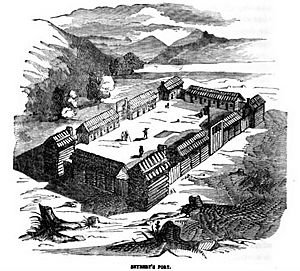Fort Seybert facts for kids
Fort Seybert was a small fort built in the 1700s in the Allegheny Mountains. Today, this area is part of Pendleton County, West Virginia, United States. During the French and Indian War (1754–1763), something terrible happened there. In 1758, Shawnee and Delaware warriors launched a surprise attack. Most of the 30 settlers hiding inside the fort were killed, and the fort was burned down.
Just one day before, a similar attack happened at nearby Fort Upper Tract. Many settlers there also lost their lives. Today, there is almost nothing left of Fort Seybert. It was located about 8 miles northeast of the town of Franklin.
Contents
History of Fort Seybert
Why the Fort Was Built
After a big battle in 1755 where General Edward Braddock was defeated, settlers in the Allegheny Mountains were in danger. They faced many attacks from Shawnee and Delaware warriors. To help protect them, Virginia's soldiers, called the Virginia Regiment, started to guard some of the small forts that settlers or soldiers had quickly built.
Fort Seybert was one of these forts. It was built near a river called the South Fork of the South Branch of the Potomac River. Close by was a mill owned by John Patton. Patton sold his land to Jacob Seybert in 1755, and that's how the fort got its name.
A young commander named George Washington, who was only 24, was in charge of the Virginia Regiment. He worked hard to protect the settlers. He planned to build and staff forts along the frontier. Fort Seybert and Fort Upper Tract were among the places he mentioned in his reports. In 1756, Washington wrote to Virginia's leader, Robert Dinwiddie, about needing guards for places like Upper Tract.
Growing Worries
In November 1756, Washington wrote again to Dinwiddie. He was worried that settlers were becoming very scared. He feared that many families would leave the area because of the constant danger.
Washington also agreed to a plan for a long chain of 23 small forts along the frontier. He actually preferred fewer, but much larger and stronger forts. In September 1757, five people were killed and eight were captured by warriors on the South Branch. Major Andrew Lewis also worried that the whole region might have to be left empty because there weren't enough soldiers to protect it.
In April 1758, a scout named Christopher Gist and his men were on a mission. They found signs of a large group of warriors, possibly over 100, heading towards the frontier forts. It's very likely that these were the warriors who attacked Fort Upper Tract and Fort Seybert soon after.
The Attack on the Fort
On the morning of April 28, 1758, a thick fog covered the area. Many of the men from Fort Seybert were away on business. This left the fort with very few defenders, perhaps only three adult men, including Captain Seybert. They also had very little ammunition.
Seeing that they couldn't win, Captain Seybert decided to surrender. The war chief, Bemino (also known as John Killbuck), promised that the settlers' lives would be spared. However, after the surrender, the warriors broke their promise. They killed 17 to 19 people. Eleven others were taken captive, including Seybert's teenage son. This son later returned to the area years later and shared his story.
He described how the warriors tied up ten people and took them outside the fort. Then, they killed the others inside. They made them sit in a row on a log. An Indian stood behind each person. At a signal, each Indian used a tomahawk to strike their victim. A few more blows finished the terrible act.
Six days later, on May 4, Washington wrote about the sad news from Forts Upper Tract and Seybert. He said that about 60 people were killed or missing. He quickly sent soldiers and some friendly warriors to try and stop the attackers as they left.
After the attacks, Bemino's warriors took their prisoners and stolen goods back west. They followed an old trail that later became known as the "Shawnee Trail".
What Fort Seybert Looked Like
People who lived near Fort Seybert for generations passed down stories about what the fort was like. The local community is still called "Fort Seybert" today.
One description, written by Mr. Alonzo D. Lough in the 1930s, said that Fort Seybert was on the west side of the South Fork River. It sat on a raised area that sloped down to a valley on one side and dropped sharply to the river on the other.
The fort was a round fence, about 30 yards across. It was made of logs or thick wooden planks called puncheons. These logs were set upright in the ground, side by side, and stood about twelve feet tall. A wooden door closed the entrance. Inside this fence was a two-story blockhouse, which was a strong building about 21 feet square. From the upper windows, defenders could shoot at anyone trying to attack the fort.
An Old Drawing of the Fort
In 1851, a historian named Wills De Hass published a picture of Fort Seybert. This picture, a wood engraving, shows the fort as a large, square stockade. It looks more like a trading post and fort combined, big enough for many soldiers. However, no one has ever confirmed if this picture is truly accurate. Many amateur historians have used it as a source of information.
De Hass described the fort as "a simple enclosure, built in the middle of the forest, but strong enough to have stopped any attack if the people inside had been strong." However, people living near Fort Seybert in the 1930s remembered seeing a dip in the ground where the fort's walls once stood. They said it was impossible for the fort to have been made of almost a dozen log houses, as shown in De Hass's picture.


